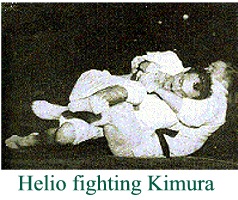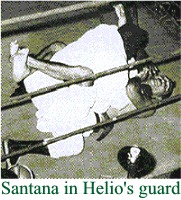








History
Enter the Gracie Family
Carlos Gracie was the son of Gastao and Cesalina Gracie. Gastao's father, George Gracie, had immigrated from Scotland years earlier. Gastao had asked Conde Koma, or Mitsuyo Maeda, to teach his son, Carlos Gracie, his art of Judo. Maeda agreed and began his lessons. Carlos actually only studied about a year with Maeda himself before he had to leave again. Carlos continued his training with the Brazilian assistant instructors that Maeda had put in place to teach the students in his absence. Carlos would then teach the techniques to his brothers.
Carlos opened his own school in 1925 under the name of the Gracie Jiujitsu Academy. The name of Judo had been changed back to Jiujitsu to reflect its combat attitude. The Gracie's Jiujitsu was not focused on points, it was focused on simply making the opponent give up with a submission technique or to carry the technique to its completion, much as the older style of Judo once was and still existed in the Kosen style. The new name was to separate it from its sport counterpart of Judo. This was not about sport, this was about fighting.
Carlos had four younger brothers: Oswaldo, Gastao Jr., Jorge and Helio. Helio was often on the sidelines watching his brothers practice because of his poor physical condition, but he was learning much as he watched. One day, a student showed up for his private lesson with Carlos, but Carlos was late. Helio decided that he would teach the lesson since he had watched his brothers for years and was sure that he could teach as well as he needed to. In fact, as the lesson ended and Carlos burst in apologizing for his being late, the student said, "That's alright, your brother gave me a good lesson, and if you don't mind, I'd like him to teach me from now on." This began Helio's career in Jiujitsu.
The Gracies Take on the World
 Just as Maeda challenged other schools and fighters, so too the Gracie brothers
began challenging anyone and everyone. Boxers, wrestlers, Karate men and
champions of all styles were fought and beaten by Gracie Jiujitsu. Helio first
stepped in the ring at the age of 17 and soon became the strongest fighter in
the Gracie Family.
Just as Maeda challenged other schools and fighters, so too the Gracie brothers
began challenging anyone and everyone. Boxers, wrestlers, Karate men and
champions of all styles were fought and beaten by Gracie Jiujitsu. Helio first
stepped in the ring at the age of 17 and soon became the strongest fighter in
the Gracie Family.
Eventually, Helio sent a challenge to the current Judo Champion and one of the greatest Judoka of all time, Masahiko Kimura, in 1952. Kimura accepted the challenge, but took two assistants with him. If Helio could not defeat his assistants then he would not even bother with him. Helio's first match was with Kado, a 5th degree black belt. Helio choked Kado into submission from the guard 6 minutes into the fight. Kimura accepted the match.
Weeks
later, the match was scheduled in front of 20,000 spectators and it was given
the largest possible media coverage. The Gracie's brought in a coffin for Kimura as a symbol
as to how they thought the fight would end.
possible media coverage. The Gracie's brought in a coffin for Kimura as a symbol
as to how they thought the fight would end.
During the fight, Kimura threw Helio many times with very powerful throws. The Gracie's, however, had brought in very thick mats for the fight so that Helio would not sustain too much damage from the throws. In pictures, you can see their bodies sinking into the mat as they grapple. After 12 minutes of punishing throws and submission techniques, Kimura caught Helio in an armlock and had to break his arm in order to get Helio's corner to throw in the towel. Helio would still not tap, even with a broken arm.
Kimura would later comment on Helio's fighting spirit, and the armlock that broke Helio's arm is still called the Kimura by BJJ stylists to this day. Kimura also later noted that Helio's Jiujitsu reminded him of the old pre-WWII style Judo, which is obvious considering they were taught by Maeda himself.
 In 1957, Helio would suffer his second major loss against a former student named
Valdemar Santana. They had what is believed to be the longest match in Jiujitsu
history with 3 hours and 45 minutes of punching, kicking, elbowing, knees and
headbutts along with vigorous grappling looking for submissions of all types. It
was not until regaining their feet that Santana was able to connect with a kick
to Helio's head as he was standing. Helio went down and the match was finally
over. Helio was 45 years old at the time, this would be his last fight.
In 1957, Helio would suffer his second major loss against a former student named
Valdemar Santana. They had what is believed to be the longest match in Jiujitsu
history with 3 hours and 45 minutes of punching, kicking, elbowing, knees and
headbutts along with vigorous grappling looking for submissions of all types. It
was not until regaining their feet that Santana was able to connect with a kick
to Helio's head as he was standing. Helio went down and the match was finally
over. Helio was 45 years old at the time, this would be his last fight.
With Helio's loss to Santana, Carlson Gracie, the son of Carlos, would enter the ring at the age of 17 to avenge the family name. He defeated Santana and earned the title of "king". They would fight again for a total of 6 times with Carlson winning four and drawing for two.
Gracie Jiujitsu Goes to America
Helio eventually had sons of his own who followed in the tradition of the Gracie family style of martial arts. The family continued to challenge all takers and were undefeated since Helio was beaten by Kimura. Eventually, one of Helio's sons, Rorian, decided that it was time to take Gracie Jiujitsu out to the world, and where better to start than America?
Rorian had made a trip to America in the late 1970's and started teaching in the early 1980's. He was surprised to find that Americans virtually had no idea of how to fight on the ground. It was something that most schools didn't even attempt to address. To further his point, he offered $100,00.00 to anyone that could beat their style in a no-rules competition.
In 1993, Rorian's brother, Royce, took Gracie Jiujitsu to the world by entering the first Ultimate Fighting Championship and easily winning the entire event against fighters that were two and three times his size. He did it again in UFC 2 and UFC 4. This opened the door for many Brazilians to come to America to fight against fighters from all over the world. Gracie Jiujitsu suddenly realized a huge surge in popularity. As people realized that this was one of the most effective styles to come along in years they scrambled to learn as much as they could.
Suddenly, America was the land of milk and honey for any and all instructors of Jiujitsu from Brazil. Rorian suddenly saw his new empire being fed upon by people other than his own family. So, in an effort to keep all of the money for themselves, he had the term "Gracie Jiujitsu" copyrighted so that only the people in their organization directly under Helio could use it. Thus, the term Brazilian Jiujitsu began to replace it in the common language.
The marketing of Gracie Jiujitsu began to also include the false propaganda that if you were not directly learning from Helio or his sons themselves then you were receiving inferior training and not the "true" Gracie Jiujitsu. Even Carlson Gracie was not considered to be teaching "true" Gracie Jiujitsu. This was the same Carlson that avenged Helio's loss to Santana several times. This is also the same Carlson who has one of the very best fighting teams in the world that has won many titles with many champions. Yet, money was a motivator for saying that he was not teaching "true" GJJ.
The dark cloud over the Gracie name would continue to darken. During the past few years, the Gracie family, and Helio's sons in particular, would suffer several losses. Fighters all over the world began to study Brazilian Jiujitsu, if for no other reason, to learn how to beat it. Weakness have been exploited and the playing field has been more leveled. Now, the man (or woman) is once again more important than the style.
Brazilian Jiujitsu is still a great style to study, though. It has much to offer the modern martial artist, which is why we study it as one of our main styles for grappling knowledge. However, in the spirit of Bruce Lee and his Jeet Kune Do, we are not limited by any particular style and we do not put our faith into one method.
home | about | classes | fighters | staff | store | styles | events | video | contact
© 2011 All rights reserved AFSacademy.com